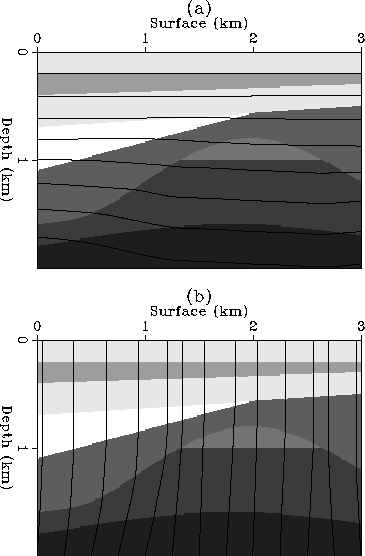




Next: CONCLUSIONS
Up: APPLICATIONS
Previous: Seismic tomography
One can use image-ray corrections to convert a migrated time-section to
a depth-section (Larner et al., 1981).
The image-rays are rays that have vertical incident angles
at the surface. Usually, the trajectories of these rays are calculated by ray tracing.
The conventional one-point ray tracing method can set the starting points of
the rays. However, it can not control the destinations of the image-rays.
Therefore, the converted depth-image has to be interpolated. For complicated
velocity models, rays may not penetrate shadow zones; the interpolation is
thus cumbersome. Using the two-point ray tracing described in this paper,
one can trace image-rays to any imaging points. The interpolation is done
in the input time-section that is uniformly sampled. In Figure ![[*]](http://sepwww.stanford.edu/latex2html/cross_ref_motif.gif) ,
I show the image-rays calculated with the fast two-point ray tracing algorithm.
The destinations of these rays are uniformly distributed along
the bottom of the slowness model.
ttod
,
I show the image-rays calculated with the fast two-point ray tracing algorithm.
The destinations of these rays are uniformly distributed along
the bottom of the slowness model.
ttod
Figure 4 Image-rays with uniformly spaced destinations. The background shows
the slowness model. High intensities denote high velocities or low slowness.






Next: CONCLUSIONS
Up: APPLICATIONS
Previous: Seismic tomography
Stanford Exploration Project
12/18/1997

![[*]](http://sepwww.stanford.edu/latex2html/cross_ref_motif.gif) ,
I show the image-rays calculated with the fast two-point ray tracing algorithm.
The destinations of these rays are uniformly distributed along
the bottom of the slowness model.
,
I show the image-rays calculated with the fast two-point ray tracing algorithm.
The destinations of these rays are uniformly distributed along
the bottom of the slowness model.
